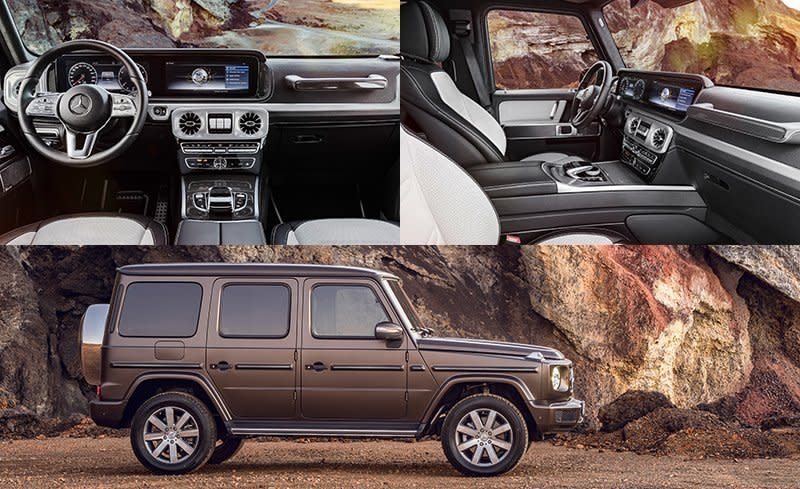2019 Mercedes-Benz G-class Dissected: Design, Interior, Powertrain, and More!

From the March 2018 issue
Automotive designers will tell you there’s nothing harder than redesigning an icon. Which is why Mercedes left the Geländewagen largely untouched for almost 40 years. The outgoing G wasn’t an icon because it was smartly packaged or drove well, though. Its on-road dynamics were decidedly Bronze Age. And while it may have been just the truck you needed if you were an overthrown dictator trying to get the hell out of one of the stans during a military coup and you didn’t exactly use the money to build roads, it was glorious overkill for the Realtor of the Year getting the heck on the darn I-5 during rush hour. The extent to which the former scenario lends adventurous atmospherics to the latter is the essence of the modern-day G, and it’s what must be maintained. Based solely on looks, which is what primarily matters to most, we’d say Mercedes has done it. The 2019 Mercedes-Benz G-class will go on sale toward the end of 2018.
Styling
Its nose is a little more rounded than before and the 2.5-inch increase in overall width is noticeable, but the G-class’s rugged character is retained—nay, heightened. The near-vertical wall of a windshield has miraculously stuck around, though it is now almost imperceptibly raked in the interest of fuel economy and reduced noise—contrasting with out-of-place aero mirrors. Even the big fender-mounted blinkers remain, as does the thick strip that flanks the whole truck. And yes, closing a door still sounds like the hatch dropping on a battle tank.

It looks so similar to its predecessor that most people likely won’t know the difference, but only three parts carry over from the old G to the new: the spare-tire cover, headlight washer nozzles, and door handles. It’s longer and wider but, Mercedes says, over 350 pounds lighter, too. Jeep has its "Trail Rated" badge, and now the G-Wagen is "Schöckl proved." Schöckl is a 4741-foot peak near Graz where Mercedes puts test mules through more than 1200 miles of ascents and descents.
Interior
There’s little doubt inside that the G is new. There are unexpected novelties such as real cupholders, but the redesign hardly stops there. Almost every dimension offers a little more wiggle room, and rear-seat legroom grows by a significant 5.9 inches, which means regular humans can actually fit back there. The stretched wheelbase also means those passengers no longer have to awkwardly navigate the rear wheel arch while getting in and out.
The G550 will have a 12.3-inch COMAND display as standard. A second screen that replaces the analog instrument panel with a digital representation is optional, and the resulting extra-wide digital dash looks more at home here than it does in the brand’s swoopier models—boxy vehicle, boxy display. One feature you won’t find in the S-class’s version of this setup is the off-road screen showing altitude, compass heading, differential status, and pitch and roll angles. The G also gets touch-sensitive buttons on the steering wheel, multiple on-road drive modes, and a G-Mode that optimizes the SUV for off-road endeavors. The key difference being that, now, it should be more at home on road, too.

The materials and finishes inside are an upgrade, but the layout should be familiar to returning G-class buyers. The center stack even retains the trio of switches sandwiched between the central air vents to control the locking differentials.
Chassis
Manufacturer Magna Steyr will still hand-build the G-class in Graz, Austria, on a ladder frame. The body shell is steel, but the hood and doors are now aluminum. Mercedes stretched the truck’s wheelbase by 1.6 inches and its overall length by 2.1. To improve the vehicle’s road manners, the company fitted the G-wagen with one of those newfangled independent front suspensions in place of the front solid axle. The live axle remains out back, but the addition of a Panhard rod should better control its movement. And instead of the old recirculating-ball steering—one of the last such systems on the market—Mercedes used a full-blown, electrically assisted, variable-ratio rack-and-pinion setup.

The new G550 has better approach and breakover angles than the old one (31 and 26 degrees, respectively; improvements of one degree each), about a quarter-inch greater ground clearance, and almost four inches more fording ability. And it can cling to steeper side slopes.
Powertrain
The G550 will continue to use Mercedes’ twin-turbocharged 4.0-liter V-8 with 416 horsepower and 450 pound-feet of torque, but the engine will gain cylinder deactivation for this model. The AMG G63—to be unveiled this spring—will lose the twin-turbo 5.5-liter and move to a hotted-up version of the same 4.0. In other AMG applications, this engine makes anywhere from 469 to 603 horsepower and from 465 to 664 pound-feet of torque. We’d expect the mega-G’s tune to end up on the higher end of that spectrum.
In either trim, the seven-speed automatic has been dropped in favor of the new nine-speed transmission. The rest of the G-wagen’s drivetrain is no less off-road capable than before, offering full-time all-wheel drive with the ability to lock the center, rear, and front differentials. In the case of Mercedes’ old war horse, evolving doesn’t necessarily mean it has to change much.

 Yahoo Autos
Yahoo Autos 